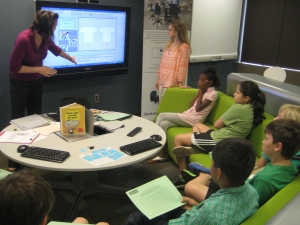What comes to mind when you hear the term “classrooms of the future”? What do you envisage they would look like? What features would you include? What would you get rid of?
These are just some of the key questions that can start discussions about creating an ideal classroom learning space. However, all too often, we are neglecting to seek the answers to these questions from the one group whose opinion matters the most – our students! “The children’s perspective on the designed classroom is often overlooked in the design-decision making process”. (Read, 2010, p.76).
Classrooms are not merely a physical structure designed to contain our pupils in one place and protect us from the outside elements of mother nature. Yet, more often than not, teachers (and schools) may be inclined to resign themselves to the fact that they don’t have the means or the ability to change classroom spaces significantly enough, and so as a result, very little is done at all. This is part of the reason why we still see classrooms that remain virtually identical to when we were in school ourselves.
Taking the initiative to start creating classrooms of the future is not necessarily about installing the latest-and-greatest educational equipment on the market (although, some of that might be nice!). Instead, it is about designing an environment within the space you and your students have been assigned to call your own. Features you will consider will include things such as lighting, colour, furniture arrangement, natural light and so forth. However, it is more often the next layer of design where your “classroom of the future” will start to create an authentic learning atmosphere that supports you as a teacher, and more importantly, your students as learners.
Children are perceptive when considering how a space makes them feel. As stated by Read (2010, p.76), “young people are passionate observers of the environment and, as such, their reports of preferences for interior design principles and elements are important to understanding their perceptions of the classroom environment”. A study Read (2010, p.77) reports on identifies “themes that emerged from the children’s responses . . . were Circular and Spherical Design Elements and Windows”. “Circles and spheres provide variety in spaces where most elements are made up of rectilinear lines and forms.” (Read, 2010, p. 79).
Another study conducted by QUT interviewed students about their preferred learning spaces also noted that “Education authorities may encourage new, student centred pedagogical styles, such as collaborative learning, team-teaching and peer tutoring,but the spaces where such innovations are occurring do not always provide the features necessary to implement these styles. Heeding the views of children could result in the creation of spaces where more imaginative pedagogical relationships and student-centred pedagogical styles can be implemented”. (Bland, 2010, p.1)
What does this all mean? After all, we’re educators – not interior decorators.
Ultimately, if we as teachers were to share the ownership of our classroom spaces with our student group, we may be surprised by their insight and preferences about what is important to support their own learning as often “their insights able to assist educators and planners to see things that are important to students but that adults generally overlook”. (Bland, 2010, p.9). Also, we need to be mindful that learning is not something that can be confined to a singular space. It is fluid and ongoing process and one that may take place in “informal spaces not necessarily originally envisaged as learning spaces”. (Thomas, 2010, p.503).
By starting the conversation and considering what contribution and ownership your students have over where and how they are learning, we are taking a giant step towards creating our very own “classroom of the future”.
Happy teaching!
Image 1:
Image 2:
Image 3:
References
Bland, Derek C. (2011) Drawing on imagination : primary students’ ideal learning environments. In: AARE 2010 Conference Proceedings, 28th November – 2nd December, 2010, Melbourne, Australia.
Read, M. (2010). Contemplating design: listening to children’s preferences about classroom design. Creative Education, 2, 75 – 80
Thomas, H. (2010). Learning spaces, learning environments and the dis‘placement’ of learning. British Journal of Educational Technology, 41(3), 502–511.
Images included for educational use only
Image 1. (2012). Classroom. Retrieved on August 19, 2015. Retrieved from http://expectmiraculous.com/2012/05/07/21st-century-learning-a-visit-to-the-ga-doe-center-for-classroom-innovation/
Image 2. (2015). Classroom. Retrieved on August 19, 2015. Retrieved from http://rtschuetz.blogspot.com.au/2015/01/innovative-learning-spaces-facilitate.html
Image 3. (2012). Classroom. Retrieved on August 19, 2015. Retrieve from http://cefpi.org.au/awards/2012-awards/2012-victorian-chapter-award-winners/mt-beauty-primary-school




Great article!
I believe we do need to accommodate students’ need for a creative and inspiring space to learn and grow. After all, we work best when our minds can be stimulated and yet feel at ease and concentrate. And children have an amazing ability to pick up on the “little things” which is all the more reason to be attuned to this.
It’s interesting to note that this trend is occurring in the workforce– offices are becoming more open and geared toward sharing and collaborative spaces, and top companies are adopting various designs to accommodate this. These companies (ie: Google, Yahoo!) are also incorporating elements to create a positive environment for workers, such as comfortable chairs, healthy foods and massages (if only these could be brought to the staff room too…)
Through shifting the design of the classroom, real and lasting changes can be brought about. Students will be “in their element” in a subtle way and this will allow teachers and students to perform to a higher standard.
LikeLike